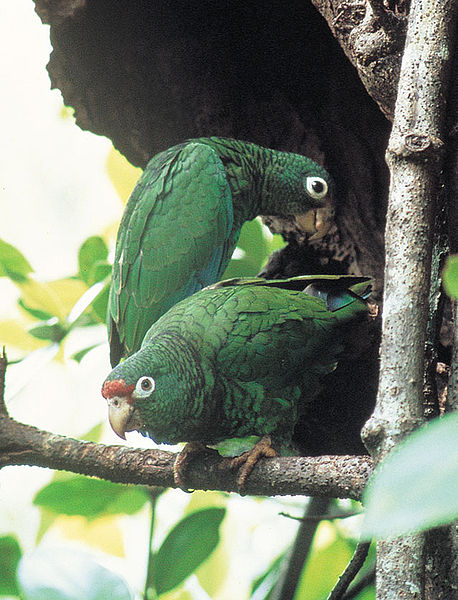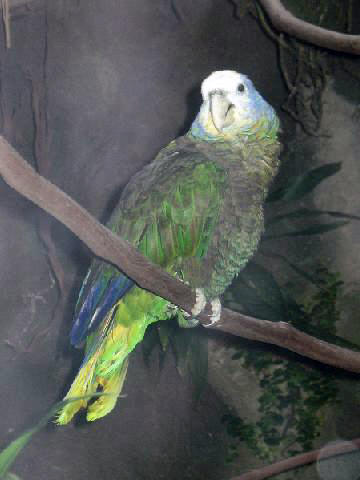Although several of the Amazon parrots are well-known to aviculturists and have long been pet trade staples, most species are actually quite rare in captivity and the wild, and several are, unfortunately, extinct. Today I’d like to introduce you to some that are not often seen outside of their native ranges. Please see Parts I and II of this article for information on commonly-kept Amazon parrots.
Extinct Species
Various Caribbean islands were the sites of several recent Amazon parrot extinctions. The Guadeloupe Amazon, Amazona violacea, was last observed in 1779, and was apparently hunted to extinction shortly thereafter. The Martinique Amazon, A. martinicana, was, according to the field notes of several naturalists and explorers, exceedingly common on its home island in the late 1700’s. By the year 1800, however, it too had disappeared – also a victim of over-hunting.
The Lesser Antilles (the string of islands stretching from Puerto Rico to Trinidad) were reportedly home to at least 2 other distinct Amazon parrot species. Unfortunately, today they exist only on the pages of travel logs and naturalists’ notebooks – preserved specimens are unknown.
Imperial or Dominican Amazon, A. imperialis
Reaching 18 inches in length and splashed in purple, brown and maroon, this magnificent parrot is the largest of its genus. Limited in distribution to a single mountainside on the tiny island of Dominica, it is also among the rarest. The wild population is estimated at 80-200 birds, and there is a small captive breeding effort.
Puerto Rican Amazon, A. vittata
 With only 30-35 individuals remaining in Puerto Rico’s Loquillo Mountains, this is quite likely the Neotropic’s rarest parrot. A related subspecies on nearby Culebra Island became extinct in 1912. The captive population of approximately 100 birds (which suffered serious losses due to thievery in 2001) is managed by the US Fish and Wildlife Service.
With only 30-35 individuals remaining in Puerto Rico’s Loquillo Mountains, this is quite likely the Neotropic’s rarest parrot. A related subspecies on nearby Culebra Island became extinct in 1912. The captive population of approximately 100 birds (which suffered serious losses due to thievery in 2001) is managed by the US Fish and Wildlife Service.
An intensive reintroduction program is in effect, with captive reared birds being given predator-avoidance training (the island hosts a large population of red-tailed hawks). However, less than 1% of the species’ natural habitat remains, and introduced black rats and mongooses pose a grave threat. Image referenced from Wikipedia Commons here.
St. Lucia Amazon, A. versicolor
 I was very fortunate to have observed this colorful and rare bird while working with leatherback sea turtles on its tiny island home. I had not really expected to see it at the time, and the intervening 20 years have not dulled the very pleasant memory.
I was very fortunate to have observed this colorful and rare bird while working with leatherback sea turtles on its tiny island home. I had not really expected to see it at the time, and the intervening 20 years have not dulled the very pleasant memory.
The species’ name – “versicolor” – suits this most strikingly-marked of the Amazons well. Its bright green feathers are rimmed in black, while blue and purple mark the head and red colors the throat and upper breast. Wild specimens, which likely number less than 500, keep to St. Lucia’s mountain forests. Image referenced from Wikipedia and originally posted by Brennan Mulroony
St. Vincent’s Amazon, A. guildingii
 Another oddly marked (for an Amazon parrot) Caribbean island denizen, this parrot’s plumage contains a good deal of black, blue and violet, offset by orange, red and white about the head.
Another oddly marked (for an Amazon parrot) Caribbean island denizen, this parrot’s plumage contains a good deal of black, blue and violet, offset by orange, red and white about the head.
Advanced aviculturists and several zoos are working to produce captive offspring to offset the massive decline in the wild population. Image referenced from Wikipedia and originally posted by Stavenn.
Yellow-Billed Amazon, A. collaria and Black-Billed Amazon, A. agilis
Jamaica’s only 2 parrot species are both highly endangered. Neither was very well-known in US collections until comparatively recent times – the yellow-billed being first bred in 1963 and the black billed in 1978. Both are now occasionally available in the pet trade, and deserve serious attention from those with the experience and resources to attempt captive breeding.
Red-Browed Amazon, A. rhodocorytha
 The word “bright” comes to mind the first time one views this bird’s brilliant blue, green and red plumage…usually that view is of a photo, unfortunately, as the bird itself is exceedingly rare. All but 2 of the specimens known to be in the USA are housed at Florida’s Rare Species Conservancy.
The word “bright” comes to mind the first time one views this bird’s brilliant blue, green and red plumage…usually that view is of a photo, unfortunately, as the bird itself is exceedingly rare. All but 2 of the specimens known to be in the USA are housed at Florida’s Rare Species Conservancy.
Captives breed fairly well, but, as only 2-10% of its rainforest habitat in eastern Brazil remains, re-introductions are not likely. The scant reports that filter out of that area indicate that nest-poaching and deforestation continue at an alarming pace. Image referenced from Wikipedia and originally posted by Duncan Rawlinson
The Houston Zoo has long been involved in parrot conservation efforts, and was the first US institution to breed the St. Vincent’s Amazon. You can read about their recent progress with this species at:
 That Bird Blog – Bird Care and History for Pet Birds
That Bird Blog – Bird Care and History for Pet Birds
